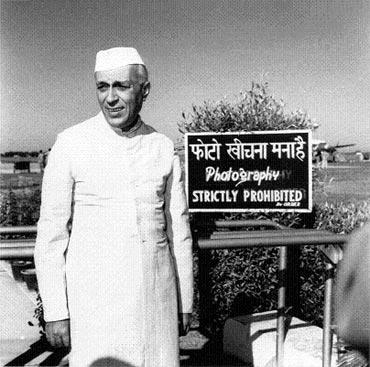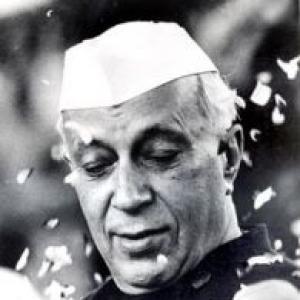Jawaharlal Nehru did not unfurl the Tricolour at the Red Fort on August 15, 1947.
But, in a gesture of nationalistic symbolism -- one that has endured by repetition over the 76 years of independent India -- Nehru took to the ramparts at Red Fort's Lahori Gate on August 16, 1947, unfurled the Tricolour there and delivered his first Independence Day speech.

Last month, as the streets of Delhi were flooded by an overflowing Yamuna, the Red Fort was caught in a time warp.
Images of the river's waters flowing beneath the arch bridge linking the adjacent Salimgarh Fort with the red fortress were reminiscent of Mughal-era paintings from the 19th century that show the once-mighty river skirting the waning empire’s central seat of power, lapping at its red sandstone walls.
A river, one memorable social media post noted, never forgets its old course.
The Yamuna's brief visit to its old stomping grounds also makes an important commentary on the city's largest monument.
In a city, nay country, where monuments mark milestones, none perhaps have witnessed history as closely as the Red Fort.
Even as preparations at the fort begin for yet another Independence Day celebration, the clamour of activities must seem but a flutter of bird wings to its ancient red ramparts, which have witnessed countless sieges, wars, demolitions, and reconstructions in their 375-year life.
Through the Mughal and British reigns, the Red Fort was stormed on several occasions by the Afghans, the Rajputs, and the Marathas. In each instance, capturing the red-walled fort marked a clear act of establishing sovereignty.
In more recent times, during the 2020-2021 Indian farmers' agitation, a group of protesters deviated from the parade to storm the fort and hoisted the Nishan Sahib (a Sikh religious flag) and peasant union flags on the mast of its rampart. Protesters would later tell the media that this was done to symbolise the paramountcy of the people's opinion.
The monument's status as a national symbol of power and sovereignty through the years, therefore, is undeniable.
At a time when names of places (such as Allahabad or Race Course) have been replaced by what the central and state governments deem more 'Indian', and when NCERT books have lost entire chapters in history, the fact that prime ministers continue to unfurl the nation's flag from its ramparts every year is testimony to the Mughal fort's entrenched status as a seat of power.

Though built between 1639 and 1648, as the centrepiece of Mughal Emperor Shahjahan's new capital Shahjahanabad, the Red Fort's association with the idea of an Indian nation began in 1857.
Author and historian Swapna Liddle points out: "In 1857, a large number of soldiers from around the country converged on Delhi, simply because Delhi had been the capital of the most powerful empire in the recent past. The emperor, though now powerless in real terms, was still a potent symbol around which many diverse elements could unite.>
Yet, the independent government that was set up in the Red Fort in 1857 was not about the restoration of an empire.
"Soldiers and citizens worked to put together a government that would run on different principles, through elected representatives," Liddle adds. Thus, it can be argued that the seeds of a democratic nation were first sown at the Red Fort.
While the revolt of 1857 was suppressed, and the British came to not only occupy but even demolish a large swathe of the fort's architecture, its association with the idea of a democratic, independent India endured.
Jawaharlal Nehru did not actually unfurl the Tricolour at the Red Fort on August 15, 1947. Rather, that ceremony took place at Princess Park near India Gate in New Delhi on the day of Independence. His 'Tryst with Destiny' speech too had by then been read out at the midnight session of the Constituent Assembly.
But, in a gesture of nationalistic symbolism -- one that has endured by repetition over the 76 years of independent India -- Nehru took to the ramparts at Red Fort's Lahori Gate on August 16, unfurled the Tricolour there and delivered his first Independence Day speech.
Why was the grand ceremony, that too late by a day, held at the Red Fort? There's no definite answer.
After the 1857 revolt dissipated, the British had taken over the fort, unleashed their fury on its structures, and made it their seat of power.
While Lord Curzon, the viceroy of India from 1899 to 1905, did order repairs and restoration of the Diwan-i-Aam, Diwan-i-Khas and several gardens, the fort primarily served as the main garrison for British forces in the capital, housing prisoners and, most infamously, hosting the Indian National Army trials in 1945.
Thus, the celebration of Independence at the Red Fort was also a definitive statement of reclamation.

The fort's strategic location also made it a symbol of centralised administration, and a lynchpin connecting several overlapping national capital regions, points out Uma Chakravarti, feminist historian and film-maker.
The old capital of Shahjahanabad, Jama Masjid, and the Meena Bazaar stretched out in front of its Lahori Gate.
In the middle of Chandni Chowk was also the Council Hall (now, the Delhi Town Hall), which housed the Central Legislative Assembly or the lower house of the Imperial Legislative Council, the legislature of British India.
And just beyond the western reaches of the old capital had sprung up Sir Edwin Lutyens' New Delhi -- the hub of British administration in India.
A stone's throw away is another older fort, Feroze Shah Kotla. For all intents and purposes, the Red Fort was the nation's central keep at the heart of several old and new capitals.
Even after Independence, the Red Fort remained a military cantonment and a significant part of the monument was under the control of the Indian Army until as recently as December 2003, when it was handed over to the Archaeological Survey of India for restoration.
"It was a natural choice. Here's a sturdy, relatively well-preserved, and elegant imperial structure whose iconicity as a seat of power had not only endured through several regime changes but had in fact been fed by these," explains Chakravarti.
"With its markets and mosques, residences and halls, in many ways it was, and remains, a self-contained capital."








